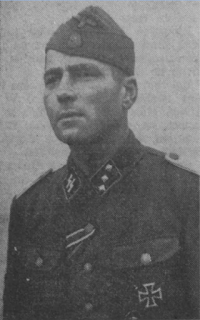Miervaldis quit theology school and headed off for the adventures of the Merchant navy far away from his home in Latvia. After getting into a tiff with his Captain, he found himself stranded in France and then joined the French Foreign Legion which he would be in its employ for the next 6 years as a cavalryman in Morocco where he acquired the nickname of "The Moroccan Terror". He then returned home and joined the Latvian Army and became an officer within the 8th Daugavpils Infantry Regiment. After the occupation of Latvia and the disbanding of its military by Soviet forces, Miervaldis joined anti-Soviet partisans and began fighting against their occupiers. After the Germans liberation then occupation of Latvia during Operation Barbarossa, the partisans then fought with the Germans against the retreating Soviets. He then joined the 26th Tukums Battalion and found himself fighting on the Minsk and the Leningrad fronts with the Latvian Brigade in the Battle of Wolchow. After recovering from wounds suffered in that campaign, he was awarded with the Iron Cross for bravery and then was given command of the 6th Company, 44th Waffen Grenadier Regiment, 19th Waffen Grenadier Division of the SS (2nd Latvian). Fighting in the Kurland Pocket
in December 1944 he was again seriously wounded and partly lost his
eyesight. His company in a single 24-hour period repelled seven attacks
by the Russians, and after the battle the bodies of 400 fallen Russian
soldiers could be counted in front of the Latvians positions. So fierce
was the fighting the Russian 100th Army Corps was completely destroyed. For this remarkable defensive success he was awarded the Knights Cross in January 1945. He would then find himself recovering in several different hospitals and during the evacuations in the path of the advancing Soviets, he refused to leave his homeland of Latvia. Once captured, he told the Soviets he was a German and he was imprisoned in Russia and used as slave labor in a silver mine. After his failed attempt to escape and make for Finland, we was executed in 1946 via firing squad. In 1993 Ādamsons was fully exonerated by the Latvian supreme court due to the findings of the United States Displaced Persons Commission investigations proclaiming that the Estonian and
Latvian SS were not found to be either criminal or Nazi collaborators and were excluded as a criminal organization as such.
Another example of how grey life can get when fighting for one evil over another.
Brian



No comments:
Post a Comment